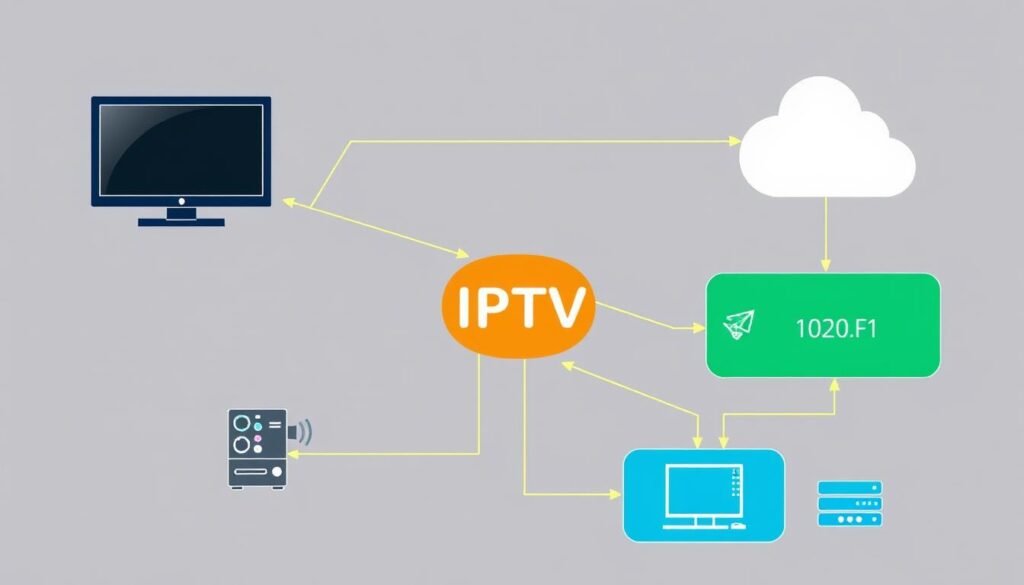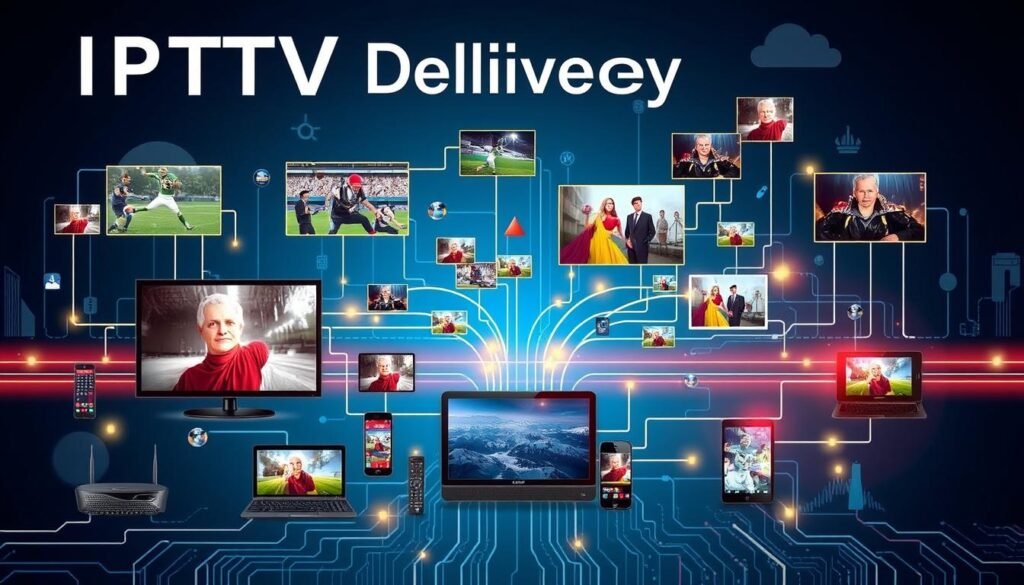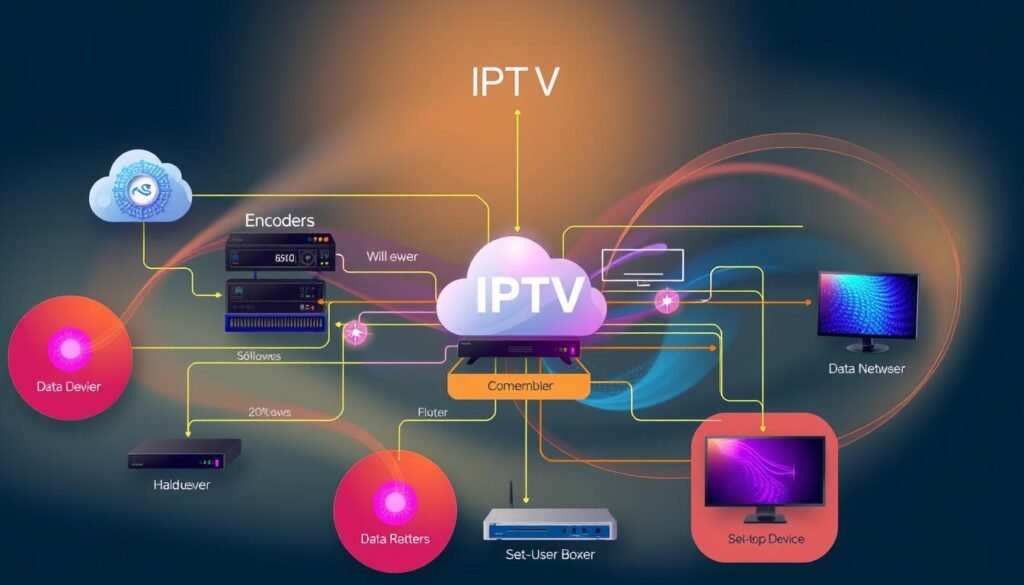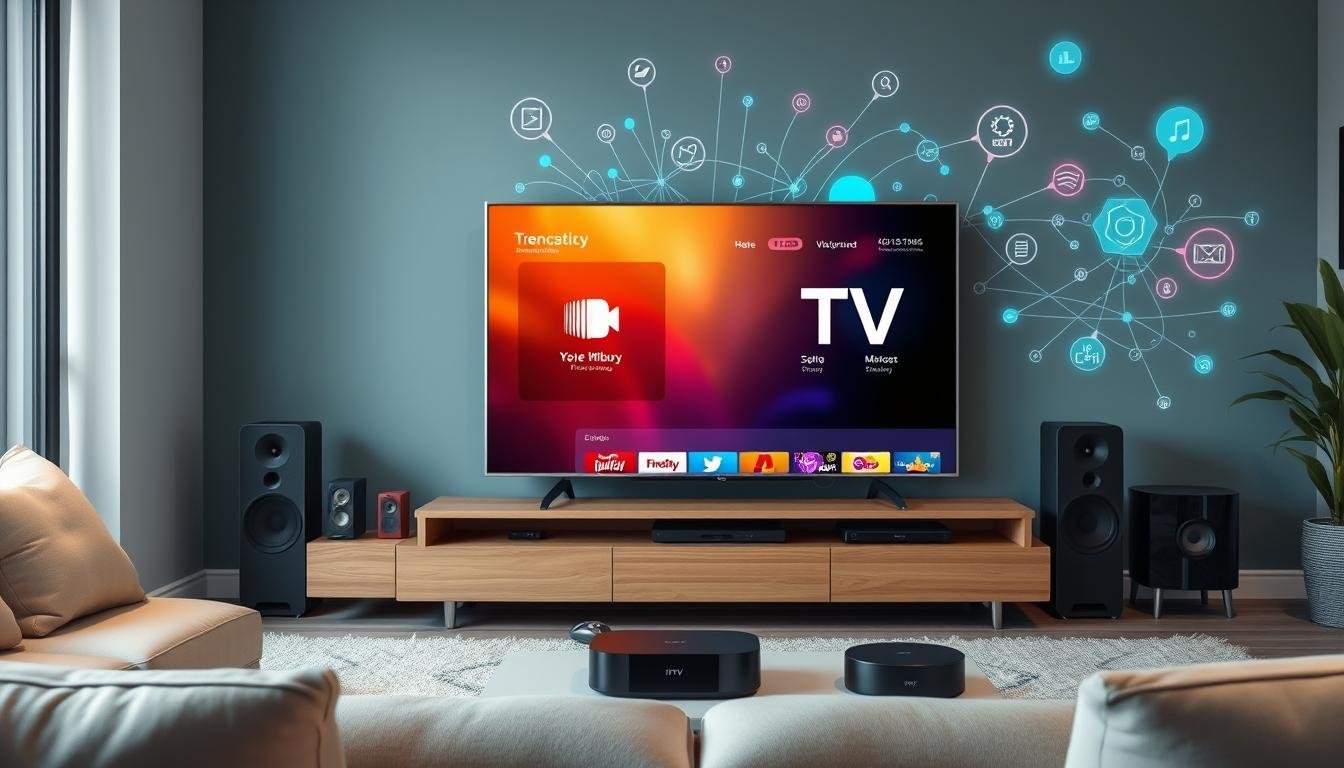In the fast-changing world of digital entertainment, IPTV (Internet Protocol Television) is a big change. It changes how we watch and interact with TV. This guide will cover the basics of IPTV, its main features, how it works, and what the future holds.
IPTV is different from old TV. It uses the internet to give a custom and engaging viewing experience. It lets users watch live and on-demand content on any device, without needing cable or satellite.
Starting to learn about IPTV technology opens up many benefits. You’ll see how it offers more flexibility, variety in content, better access, and saves money. This guide will help you understand IPTV better, so you can choose the best services and devices for you.
Key Takeaways
- IPTV technology uses the internet to bring digital TV services, offering more flexibility and personalisation.
- IPTV has features like Video on Demand, Live TV, and DVR, meeting different viewing needs.
- IPTV uses multicast and unicast protocols to manage bandwidth and ensure high-quality content delivery.
- IPTV set-top boxes and middleware are key in the infrastructure, making it easy to access many channels and on-demand content.
- The future of IPTV technology looks bright, with advancements like 5G, cloud-based solutions, and better user experiences.
What is IPTV Technology?
IPTV, or Internet Protocol Television, changes how we watch digital video. It uses the Internet to send TV services straight to our devices. This new way of watching TV brings better features and lets us choose what we watch.
Exploring the Fundamentals of IP-Based Video Delivery
IPTV works by sending digital video over the Internet. It uses IP networks to reach our devices, like smart TVs or phones. This method is more flexible and lets us watch what we want, when we want.
Benefits and Advantages of IPTV over Traditional TV
- Improved video quality: IPTV gives better video and sound, making watching more enjoyable.
- On-demand access: IPTV lets us watch our favourite shows anytime, giving us control.
- Enhanced interactivity: IPTV adds features like pause and rewind, making watching more interactive.
- Personalised content: IPTV shows us content we like, based on our interests.
IPTV changes how we watch TV by using the Internet. It makes watching TV more dynamic and personal, unlike old TV ways.
How IPTV Technology Works
IPTV technology changes how we watch digital videos. It uses Internet Protocol (IP) networks to send high-quality video streams to our devices. Let’s explore how IPTV works and its main processes.
The IPTV system has key parts that work together for a great viewing experience. First, video content is encoded into digital formats like MPEG-4 or H.264. This makes it easy to send over IP networks. Then, the video data is put into IP packets for sending across the network.
The IPTV service provider is very important. They have a central video headend that gets, processes, and manages video sources. From there, they send video streams to users using multicast or unicast protocols.
| Protocol | Description | Advantages |
|---|---|---|
| Multicast IPTV | Uses a one-to-many model, sharing one video stream with many viewers. | It saves network bandwidth by sending the same content to all users at once. |
| Unicast IPTV | Uses a one-to-one model, giving each viewer their own video stream. | It provides a personal viewing experience, allowing users to watch on-demand and control playback. |
At the viewer’s end, the IPTV set-top box or device is crucial. It decodes the video streams and shows them to the viewer. These devices have the right software and hardware to work well with IPTV, making for a smooth viewing experience.
IPTV’s success comes from using IP networks for video delivery. It offers a reliable and scalable way to watch high-quality digital videos. IPTV gives viewers a dynamic and personal viewing experience, changing how we watch digital media.

IPTV Delivery Methods
IPTV technology uses different ways to send digital video content to viewers. The main two methods are multicast IPTV and unicast IPTV. Each has its own benefits and meets certain needs.
Multicast IPTV: Efficient Bandwidth Usage
Multicast IPTV is great for saving bandwidth. It sends one video stream to many users at once. This way, the network uses resources better because the video is sent only once, no matter how many watch it.
This method is best when lots of people watch the same thing. For example, during live events or when many want to watch the same on-demand programme.
Unicast IPTV: Personalised Streaming Experience
Unicast IPTV gives a more personal viewing experience. Each viewer gets their own video stream, based on their likes and needs. It lets viewers control their viewing, like pausing, rewinding, and fast-forwarding.
This method is perfect for on-demand content. It allows for a lot of personalisation and flexibility.
| Delivery Method | Key Characteristics | Suitable Applications |
|---|---|---|
| Multicast IPTV | Efficient bandwidth utilisation, single stream to multiple users | Live events, popular on-demand programmes |
| Unicast IPTV | Personalised streaming experience, dedicated video stream per user | On-demand content, personalised viewing |
Choosing between multicast IPTV and unicast IPTV depends on what the IPTV service provider needs and what the viewers want. Knowing the good and bad of each helps service providers improve the IP video delivery and digital video transmission for their customers.

IPTV Infrastructure and Components
The IPTV infrastructure is a complex system with many parts working together. It delivers digital TV services smoothly to viewers. At its heart is the IPTV middleware, which manages and connects all parts for a great viewing experience.
IPTV Middleware: The Backbone of IPTV Systems
IPTV middleware is the software that ties everything together in an IPTV system. It includes content servers, user interfaces, and set-top boxes. It’s the key to a smooth IPTV experience.
- Content management: The middleware controls the storage, retrieval, and delivery of digital video content.
- User interface integration: It makes sure the user interface works well, letting viewers easily navigate and interact with the service.
- Device management: The middleware manages and controls the various IPTV set-top boxes and devices.
- Subscriber management: It handles user authentication, authorisation, and billing, ensuring a secure and personalised IPTV experience.
The IPTV middleware is crucial for a reliable IPTV service. It makes sure everything works together well, improving the viewer’s experience and satisfaction.
| IPTV Infrastructure Components | Description |
|---|---|
| Content Servers | Responsible for storing, managing, and delivering digital video content to IPTV subscribers. |
| IPTV Middleware | The software that integrates and orchestrates the various components of the IPTV system. |
| IPTV Set-top Boxes | Devices that connect to the IPTV network and enable viewers to access and consume digital television services. |
| User Interfaces | The graphical interfaces that allow IPTV subscribers to navigate and interact with the digital television services. |
| Subscriber Management | The systems that handle user authentication, authorisation, and billing for the IPTV service. |

The smooth working of these IPTV components, led by the IPTV middleware, is key. It ensures a high-quality and reliable digital TV experience for subscribers.
IPTV Set-Top Boxes and Devices
In the world of IPTV, set-top boxes and devices are key. They connect viewers to digital TV services. These devices make watching TV smooth and easy.
There are many types of IPTV set-top boxes. They range from small and simple to big and feature-rich. Each one aims to improve your IPTV experience.
Key Features of IPTV Set-Top Boxes
- High-definition video playback for a premium viewing experience
- Integrated user interfaces for easy navigation and content discovery
- Support for advanced features such as catch-up TV, on-demand streaming, and time-shifting
- Connectivity options, including HDMI, Ethernet, and wireless networking, enabling seamless integration with home entertainment systems
- Compatibility with a wide range of IPTV services and digital television providers
But IPTV isn’t just about set-top boxes. It also includes smart TVs, media players, and mobile devices. These devices let you watch IPTV anywhere, anytime.
| IPTV Set-Top Box | Smart TV | Streaming Media Player |
|---|---|---|
| Dedicated device for IPTV access | Integrated IPTV capabilities | Portable device for IPTV streaming |
| Provides a comprehensive IPTV experience | Convenient all-in-one solution | Flexible and versatile IPTV access |
| Requires external connection to TV | Eliminates the need for additional devices | Connects to any display with HDMI |
With so many IPTV devices available, finding the right one is easy. This makes IPTV a big part of our digital TV world.
IPTV Technology in Action
IPTV technology is changing how we watch TV. It’s used in entertainment, education, and healthcare. This new way of watching TV is making a big difference.
Revolutionising the Entertainment Industry
IPTV has changed the entertainment world a lot. It lets content providers give viewers what they want, when they want it. This makes watching TV more fun and personal.
Enhancing Education through IPTV
In schools, IPTV is making learning better. Teachers can share videos and lessons online. This helps students learn in new and exciting ways.
Transforming Healthcare with IPTV
IPTV is also helping in hospitals. It lets patients watch educational videos and even see doctors online. This makes their stay better and helps them get better faster.
IPTV is really versatile and powerful. As more people use it, we’ll see even more cool things. It’s changing how we watch TV and interact with the world.
Challenges and Limitations of IPTV Technology
IPTV technology brings many benefits but also faces challenges. One big issue is needing a fast and stable internet connection. IPTV needs a reliable internet, which can be hard to find in some places, especially rural areas.
Another big problem is the complexity of setting up IPTV systems. It involves many parts, like set-top boxes and network systems. This setup can be tricky and needs special skills and a lot of money.
| Challenge | Description |
|---|---|
| Network Bandwidth Constraints | IPTV needs a lot of internet speed, which can be a problem in places with slow or unreliable internet. |
| Content Licensing and Rights Management | Dealing with content rights can be hard for IPTV providers. It affects how much content they can offer. |
| Evolving IPTV Standards and Protocols | Keeping up with new IPTV standards and protocols is a challenge. It requires ongoing investments in new technology. |
Despite these challenges, IPTV’s future looks bright. People in the industry are working hard to solve these problems. They aim to make IPTV better for everyone.
“As the IPTV industry continues to evolve, providers must find innovative ways to overcome the challenges and limitations inherent in the technology, ensuring a seamless and engaging viewing experience for their customers.”
IPTV Technology: Future Trends and Developments
The world of digital TV is changing fast. Soon, we’ll see more stunning visuals with 4K and 8K streaming. Artificial intelligence and machine learning will also change how we use IPTV, making it more personal.
Cloud-based IPTV is another big change coming. It will make TV services more flexible and affordable. This meets the changing needs of viewers.
5G technology is also on the way. It will make watching TV smoother and faster. This means better quality and more interactive features for all devices.
The future of IPTV looks bright. We can expect better visuals, more personal content, and services that are easy to use. This will change how we watch our favourite shows.
| Emerging Trend | Impact on IPTV Technology |
|---|---|
| 4K and 8K Video Streaming | Enhances visual quality and offers a more immersive viewing experience for consumers. |
| Artificial Intelligence and Machine Learning | Improves content recommendation and personalisation, enhancing user engagement and satisfaction. |
| Cloud-based IPTV Services | Provides greater flexibility, scalability, and cost-effectiveness for service providers and consumers. |
| 5G Technology | Enables seamless delivery of high-quality IPTV content and interactive features with low latency. |
These trends will shape the future of digital TV. They promise a more immersive, personal, and easy-to-use experience for everyone.
Conclusion
IPTV technology is changing the TV and digital video world. It uses IP-based video delivery to bring many benefits. This makes it a great choice for both providers and viewers.
IPTV offers efficient multicast and personalised unicast services. It’s changing how we watch digital TV. The IPTV system, with its middleware and set-top boxes, makes watching TV smooth and engaging.
The future of IPTV looks bright. We’ll see new technologies, more content, and better user experiences. By keeping up with IPTV, everyone can enjoy a new world of digital media.

